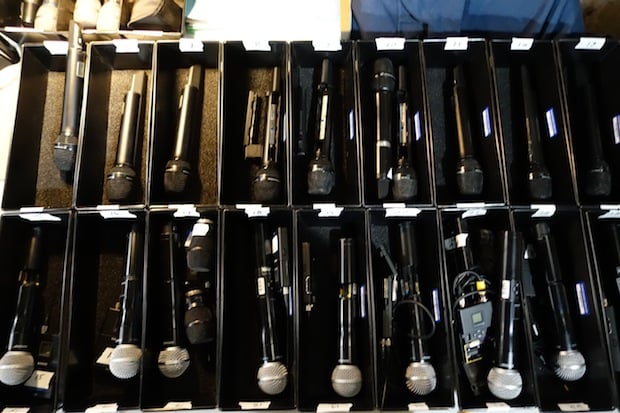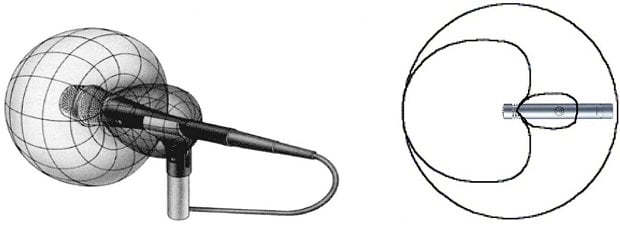 Image via forbes.com
Image via forbes.com
In the world of audio, not all microphones are created equal. For the most part, all microphones do the same thing: take a physical sound and translate it into something that we can control electrically. The way in which they go about doing it, however, can make all the difference in having the best sound you can onstage and in the studio. I thoroughly encourage musicians to get to know microphones, find out which ones work best for them, and own their own mics for that purpose.
The two major factors that go into how a mic will "sound" are the capsule type and the pickup pattern. The pickup pattern of a microphone is the classification for how a microphone picks up sound directionally and its sensitivity to sound based on how the microphone is oriented. Here are the four major pickup patterns that you'll frequently encounter in the microphone world, and in which situations you'll want to use them.
Omnidirectional
 Image via media4ed.net
Image via media4ed.net
Best for:
- Studio environments where capturing a sound in a "space" is desired
- Highly controlled live sound situations, especially when looking for a clear, natural, open sound without wind or breath pops/noise, or coloration of sounds not directly in front of the microphone (off-axis)
What the pros use:
Omnidirectional microphones (sometimes shortened to just "omni") are mics that are sensitive to sound in all directions. Whether a sound source is above, below, next to, behind, or in front of the microphone, it'll pick up sound fairly equally – not perfectly so, but I won't bore you with the science behind that. What is attractive about these microphones is that they're coveted for their low "coloration" of a sound and their impressively flat frequency response throughout the entire spectrum of audible sound, particularly in the lower frequencies. These microphones are also less susceptible to noise from wind or the plosive (Ps and Bs) attacks of a vocalist. Because of their pickup pattern, however, these mics are rendered almost useless in most live sound settings and find their use almost exclusively in a studio environment.
Bidirectional
 Image via shure.co.uk
Image via shure.co.uk
Best for:
- Studio environments where capturing two sources with less "bleed" than an omni is required
- Situations where extreme rejection is needed (i.e., mic'ing a singer who plays guitar simultaneously in a recording)
- A necessary pickup pattern for Mid-Side or Blumlein mic'ing techniques
What the pros use:
- Royer R-121
- Cascade Fat Head II
- Again, many switchable pattern microphones have a bidirectional setting
Bidirectional mics (also called "figure eight" mics) pick up sound equally from the front and rear of the microphone. Due to the nature of how these mics function, they're incredibly insensitive to sound sources that are located immediately to the either side of the microphone (90° off-axis). This is another pickup pattern that's difficult to manage in most live sound settings, but has some interesting uses in a studio environment, particularly with creative placement because of its excellent rejection of anything to the sides of the microphone.
Cardioid
Best for:
- An all-around "workhorse" pattern for the stage and studio
- Close placement in live and studio situations to isolate sound source from surrounding sources
- Live vocal mics to help eliminate "bleed" on stage
What the pros use:
Cardioid is the first in our selection of unidirectional microphones, meaning that they're designed to pick up sound in only one direction. You might be thinking that cardioid may have something to do with "heart," and you're not wrong! The cardioid pattern can best be described as a heart-shaped pattern, making cardioid microphones sensitive to sounds directly in front of the mic and not from behind them. Finally, a microphone that excels in both the studio and the live sound world! These mics pick up very little else besides where they're pointed, making them a great first candidate for a vocal or instrument mic.
They aren't without their own cons, however. It's much more difficult to find a cardioid mic without a "character" to the way in which it picks up certain frequencies (though this isn't always necessarily a bad thing). The other phenomenon common to this type of pickup pattern is what we refer to as the "proximity effect." As a sound source approaches the microphone capsule and gets particularly close (somewhere within a few centimeters to actually touching the grille of the mic), there's a noticeable increase in the low frequency response. You may have noticed this when you get closer to a microphone and your voice sounds bigger and fuller than when you're farther away. As a vocalist, this can be exploited to add a certain warmth or fullness to the voice, but becomes problematic if a vocalist has a tendency to greatly vary his or her distance from the microphone, causing unpleasant changes in the timbre of his or her voice.
Hypercardioid or Supercardioid
 Image via media4ed.net
Image via media4ed.net
Best for:
- Capturing sound in a live environment where a more isolated sound is required
- Live vocal mics to help eliminate even more "bleed" onstage than a cardioid mic
- Studio situations and live recordings that need a highly directional and focused sound
What the pros use:
The cousin of the cardioid microphone, this type of microphone exhibits similar directional qualities with a few small, though very important, differences. These microphones are another great choice in the live sound realm, particularly for vocalists, as they have an even tighter and more directional response than similar cardioid microphones. This is great on particularly loud stages where there may be a lot of ambient noise surrounding a vocalist, and you want to hear only the vocalist in that microphone loud and clear.
On the flip side, however, this can prove problematic for active vocalists, who, due to their movements onstage, may vary the angle of their approach on the microphone, which contributes to changes in tone and general volume. Even moving a little off-axis to one side or the other on these microphones can make an appreciable difference. The other con that one must be aware of with this pattern is the little "bunny tail" to the rear of the microphone because of the capsule design. Your points of rejection now live somewhere between 110° and 125° from where the mic picks up, as opposed to directly behind it. Though nowhere near the pickup response of the figure eight-style mics, care must be taken where the rear of the microphone is pointed. As a vocalist, if you point that "bunny tail" into your floor wedge all night, nobody's going to have a good time, and feedback will be a guest artist sitting in with you for the rest of your gig.
Take this as some food for thought when considering mic choices for yourself, and as always, try things out and see what works best for you.
Aaron Staniulis is not only a freelance live sound and recording engineer, but also an accomplished musician, singer, and songwriter. He has spent equal time on both sides of the microphone working for and playing alongside everyone from local bar cover bands to major label recording artists, in venues stretching from tens to tens of thousands of people. Having seen both sides at all levels gives him the perfect perspective for shedding light on the "Angry Sound Guy." You can find out more about what he’s up to at aaronstaniulis.com.








